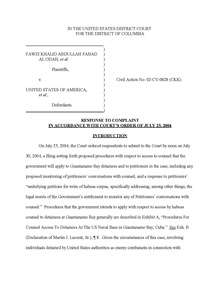Al Odah v. Bush
Civil Action No. 02-cv-0299 is a habeas corpus petition submitted on behalf of several Guantanamo captives.
Petitions incorporated in 02-cv-0299
On July 26, 2004 US District Court Judge Colleen Kollar Kotelly incorporated several other habeas petitions with 02-cv-0299: Al Odah v. United States, 02cv828 (CKK); Mamdouh v. Bush, 02cv1130 (CKK); Kurnaz v. Bush, 04cv1135 (ESH); Khadr v. Bush, 04cv1136 (JDB); Begg v. Bush, 04cv1137 (RMC); Bechellali v. Bush, 04cv1142 (RJL); El-Banna v. Bush, 04cv1144 (RWR); Gherebi v. Bush, 04cv1164 (RBW); Boumediene v. Bush, 04cv1166 (RJL); Anam v. Bush, 04cv1194 (HHK).[1]
| isn | name | notes |
|---|---|---|
| 2 | David Hicks |
|
| 38 | Ridah Bin Saleh Al Yazidi |
|
Military Commissions Act
The Military Commissions Act of 2006 mandated that Guantanamo captives were no longer entitled to access the US civil justice system, so all outstanding habeas corpus petitions were stayed.[5]
Boumediene v. Bush
On June 12, 2008 the United States Supreme Court ruled, in Boumediene v. Bush, that the Military Commissions Act could not remove the right of Guantanamo captives to access the US Federal Court system. It ruled that all previous Guantanamo captives' habeas petitions were eligible to be re-instated.
The judges considering the captives' habeas petitions were to determine if the evidence supporting the allegations that the men and boys were enemy combatants justified a classification as "enemy combatant". If so, the determination implied that the person should continue to be detained.[6]
Eligible to seek relief
On 3 July 2008 US District Court Judge Thomas F. Hogan listed this habeas petition on a list where former captives were eligible to seek relief.[7]
References
- ↑ Colleen Kollar Kotelly (2004-07-26). "Shafiq Rasul et al. v. George W. Bush et al" (PDF). United States Department of Justice. Archived from the original on October 26, 2007. Retrieved 2008-09-28.
- ↑ "David Hicks v. United States" (PDF). United States Department of Defense. 2004-10-04. pp. pages 1–19. Archived from the original (PDF) on 23 September 2008. Retrieved 2008-09-26.
- ↑ OARDEC (2008-08-08). "Index for CSRT Records Publicly Files in Guantanamo Detainee Cases" (PDF). United States Department of Defense. Archived (PDF) from the original on 26 October 2007. Retrieved 2007-09-29.
- 1 2 Brent N. Rushforth (2008-07-07). "Guantanamo Bay Detainee Litigation: Doc 12" (PDF). United States Department of Justice. Archived from the original (PDF) on 2008-09-27. Retrieved 2008-09-26.
- ↑ Peter D. Keisler, Douglas N. Letter (2006-10-16). "NOTICE OF MILITARY COMMISSIONS ACT OF 2006" (PDF). United States Department of Justice. Archived from the original on 2 October 2008. Retrieved 2008-09-30.
- ↑ Farah Stockman (2008-10-24). "Lawyers debate 'enemy combatant'". Boston Globe. Archived from the original on 24 October 2008. Retrieved 2008-10-24.
- ↑ Thomas Hogan (2009-07-03). "Petitioners seeking habeas corpus relief in relation to prior detentions at Guantanamo Bay". United States Department of Justice. Archived from the original on 2008-11-12. Retrieved 2008-11-12.
